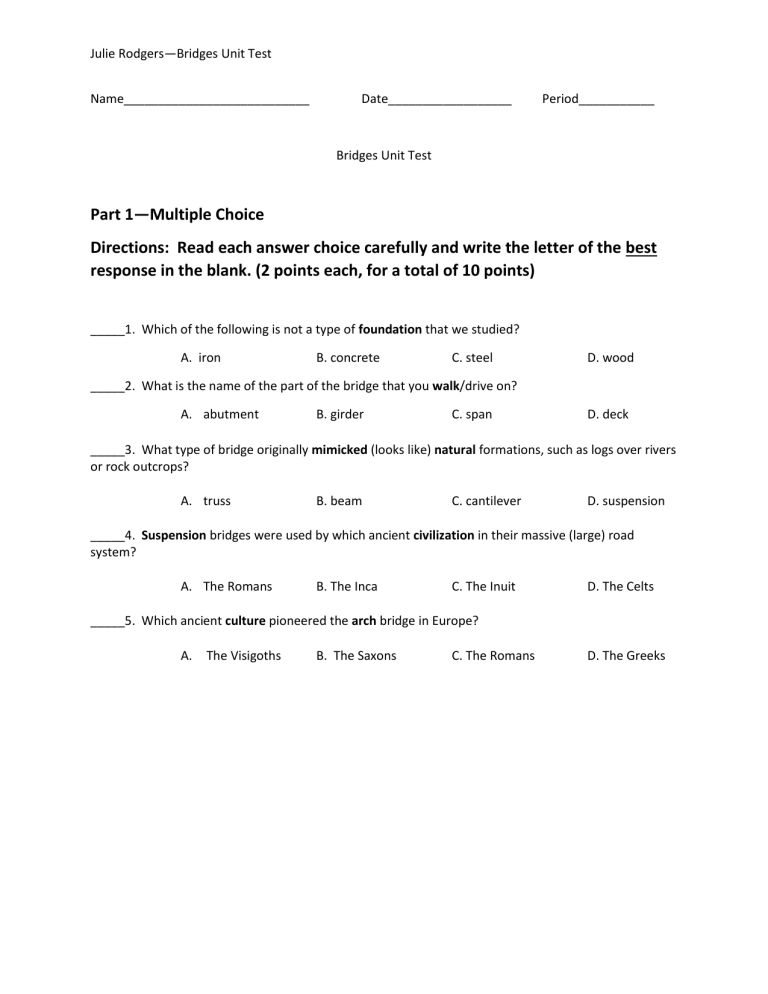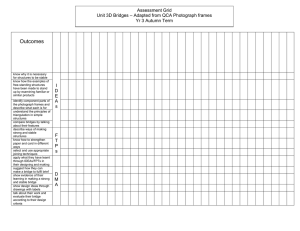
Julie Rodgers—Bridges Unit Test Name___________________________ Date__________________ Period___________ Bridges Unit Test Part 1—Multiple Choice Directions: Read each answer choice carefully and write the letter of the best response in the blank. (2 points each, for a total of 10 points) _____1. Which of the following is not a type of foundation that we studied? A. iron B. concrete C. steel D. wood _____2. What is the name of the part of the bridge that you walk/drive on? A. abutment B. girder C. span D. deck _____3. What type of bridge originally mimicked (looks like) natural formations, such as logs over rivers or rock outcrops? A. truss B. beam C. cantilever D. suspension _____4. Suspension bridges were used by which ancient civilization in their massive (large) road system? A. The Romans B. The Inca C. The Inuit D. The Celts _____5. Which ancient culture pioneered the arch bridge in Europe? A. The Visigoths B. The Saxons C. The Romans D. The Greeks Julie Rodgers—Bridges Unit Test Part 2: True—False Directions: Read each statement below carefully. Place a T on the line if you think a statement it TRUE. Place an F on the line if you think the statement is FALSE. If you have questions, raise your hand and ask your teacher. (2 points each, for a total of 20 points). The two main forces that act on a bridge at any given time are compression and repression. _____6. _____7. Usually, a poor foundation can be easily fixed. _____8. Sometimes, foundations must go deeper into the ground than a structure is tall. _____9. The three types of foundations are shallow, deep, and semi-deep. _____10. One challenge to building in a narrow mountain canyon is that sometimes there are no flat or straight open areas for road surfaces. _____11. Engineers are continually refining the materials used to make the members (beams, piers, columns, girders) of a bridge to construct safe and dependable bridges. _____12. Reinforced pressure is the weight or force bearing down on the soil from the bottom of the foundation _____13. Settlement is the vertical downward movement of the foundation. _____14. Foundations are often the most overlooked part of a bridge or any building _____15. Compression is the force responsible for most bridge failures. Julie Rodgers—Bridges Unit Test Part 3: Vocabulary Matching Directions: Match the vocabulary word to its correct definition (on the left). Write the letter of the correct answer in the blank. (2 points each, for a total of 30 points) _____16. Vertical downward movement of the foundation _____17. Someone who uses science and math to design and construct structures such as buildings, bridges, and tunnels. _____18. A pushing force that presses material together. _____19. Structures that project horizontally into space, supported on only one end _____20. A bridge in which the deck is hung from cables _____21. The elongation or contraction of a material per unit length of the material _____22. The length of a bridge between two piers. _____23. A mass, as of masonry, receiving the arch, beam, truss, etc., at each end of a bridge _____24. Indicates the stiffness of a material _____25. The "top" of the bridge on which we drive or walk _____26. A pulling Force that pulls and stretches materials outward _____27. Is a design or plan that guides the builder when they are building a building or structure _____28. A part of the bridge, such as a subordinate structural beam, column or wall _____29. The ability of a material to show little or no yielding before failure _____30. The ability of a material to be subjected to large strains before it ruptures or fails A. B. C. D. E. F. G. H. I. J. K. L. M. N. O. P. Q. Ductile Span Tension Blueprint Member Brittle Compression Deck Stress Pier Strain Modulus of elasticity Abutment Engineer Cantilevers Settlement Suspension Julie Rodgers—Bridges Unit Test Part 4: Extended Response Directions: For the following questions, please provide a complete and thoughtful answer using complete sentences. Be sure to use vocabulary words and examples that demonstrate your understanding of the unit. (5 points each, for a total of 40 points) 1. What are some of the things that engineers must consider when designing bridges? 2. If you were an engineer, how would you go about designing a bridge to make sure it was safe? 3. Engineers must consider many things when designing the foundation for a bridge or structure. What are some of those things? Julie Rodgers—Bridges Unit Test 4. What happens to the size of a foundation as a building or bridge gets bigger? The foundation must increase in size. Why? 5. What are reasons why people want roadways like those in Glenwood Canyon? 6. Why does it matter to us that engineers are careful to balance the cost of a bridge with their design decisions? 7. Explain at least 3 factors influence bridge cost. 8. What factors do you think are most important in the cost of a bridge? Be sure to back up your opinion with examples from our unit. You can use famous bridge examples if you wish.


